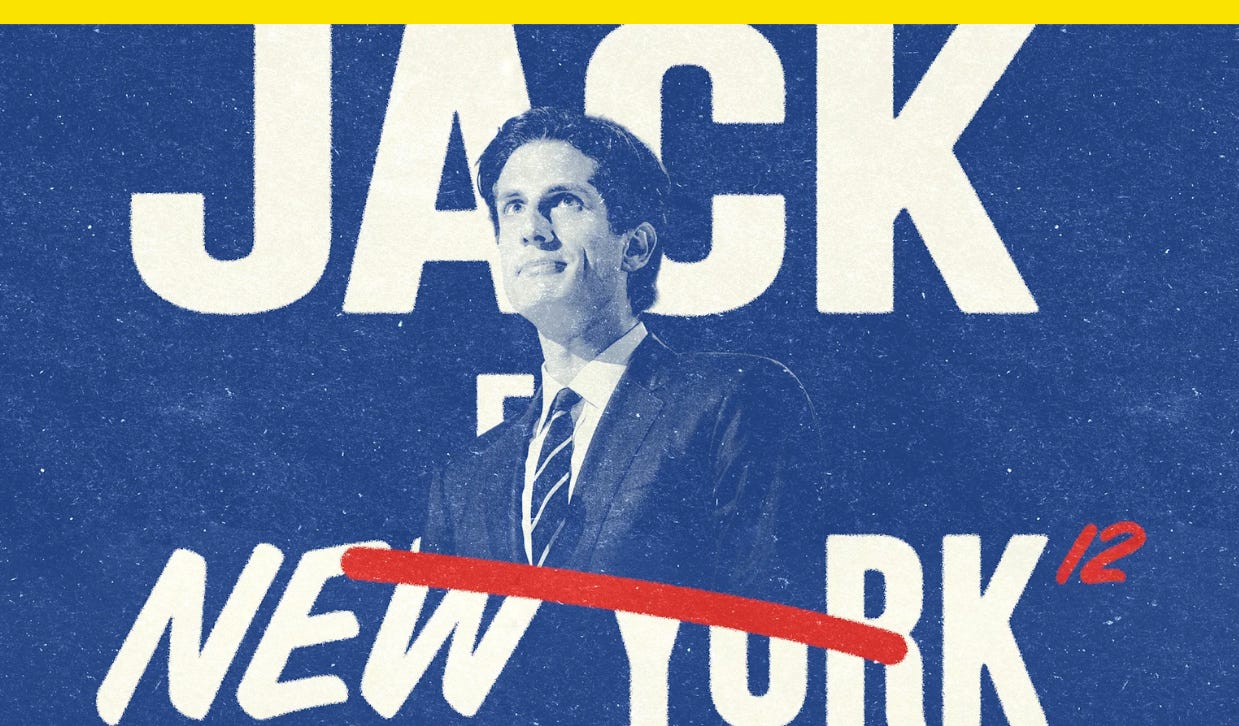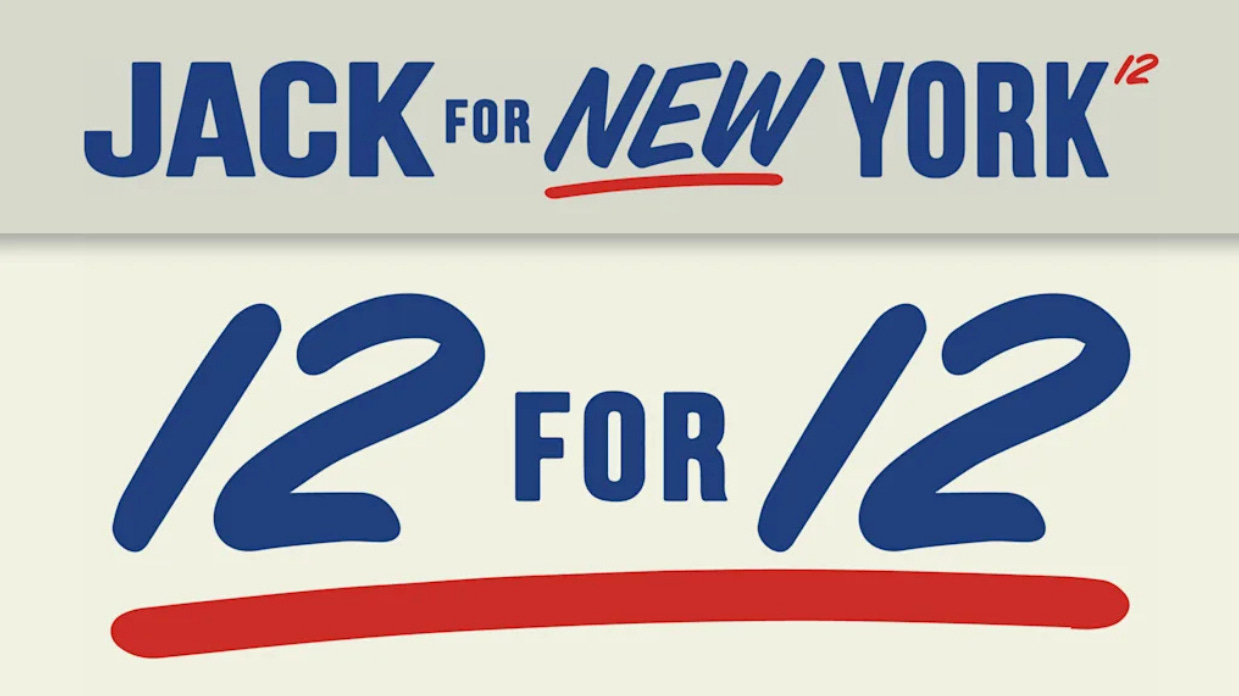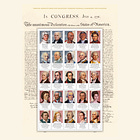Here's what a modern Kennedy campaign looks like now
Plus: Trump’s Defense Department rebrand could cost as much as $2 billion
Jack Schlossberg announced he’s running for Congress. And instead of using his last name in his campaign logo, the 32-year-old—born John Bouvier Kennedy Schlossberg—is using the nickname he shares with his famous grandfather, John F. Kennedy.
Schlossberg’s “Jack for New York” logo underlines the “New” in the city’s name in red as if to emphasize a new generation. A red “12” appears in small print at the top right of “New York” to indicate he’s running to represent Manhattan’s 12th District in the U.S. House.
Schlossberg tagged designer and Only NY cofounder Micah Belamarich in a social media post showing the logo. Belamarich did not respond to a request for comment.
It’s standard operating procedure for candidates to use their last names in political logos, though there are notable exceptions (hi, Bernie!). One study of 2020 campaign logos found female candidates are more likely to use their first names in their logos than male candidates, as their first names communicate their gender to voters in a simple way. For Schlossberg, his first name connects him to the Kennedy family legacy without saying “Kennedy.”
“Let’s Back Jack” was a slogan used in support of Kennedy in 1960. In 2026, it will be a rallying call for Schlossberg in what could be a competitive primary to replace outgoing Democratic Rep. Jerry Nadler in one of the most Democratic districts in the country. Already, two New York state assemblymen, Micah Lasher and Alex Bores, are running for the seat.
The campaign has found other ways to give a nod to the candidate’s storied political heritage without explicitly referencing the Kennedy name. Schlossberg’s logo and branding use typography that evokes mid-20th-century signage (check the “Our Man Jack” sign in the background of one shot in this Instagram gallery) alongside a contemporary take on the classic red, white, and blue color palette.
A “12 for 12” list on the campaign website lists off not policy proposals, but rather 12 “promises to the people of New York’s 12th District” that sound like qualifications for a John F. Kennedy Profile in Courage Award, including service, strength, accountability, and optimism.
Overall, it’s a brand that’s nostalgic but still feels contemporary, and combined with Schlossberg’s name recognition and vociferous social media posting, it’s one that could find success in a city that just elected another well-branded and social media-fluent candidate as mayor.
“This is the best part of the greatest city on earth,” Schlossberg said about the district in his announcement video on TikTok, calling New York “the financial and media capital of the world.” He added: “This district should have a representative who can harness the creativity, energy, and drive of this district and translate that into political power in Washington.”
Though JFK’s presidential campaign happened 65 years ago, it continues to inspire political branding and advertising, even across party lines. A super PAC ran a 2024 Super Bowl ad for Schlossberg’s cousin, Health Secretary Robert F. Kennedy Jr., that ripped off one of the 1960 Kennedy campaign ads. And today, there’s campaign merch available for Republican Sens. Ted Cruz of Texas and Josh Hawley of Missouri that mimics the style of JFK’s, with the candidates’ portraits on a background of horizontal red, white, and blue stripes.
Images of Schlossberg on his campaign website pay homage to his famous family. One shot of Schlossberg backlit against a wall that’s decorated with U.S. and New York flags recalls a photo of a 29-year-old Kennedy running for Congress, while photos of Schlossberg in a suit on a bike emulate his uncle, George magazine founder John F. Kennedy Jr.
By evoking the Kennedy dynasty through image, typography, and nickname, Schlossberg is tapping into his family legacy without using the famous family surname. “Jack” says enough.
This story first appeared in Fast Company.
These three Bob Ross paintings just sold for more than $600K
The paintings were all from the early 1990s.

Bob Ross Inc. announced last month that it would auction off 30 of the late artist’s paintings to raise money to pay for licensing fees for public television stations hit by Trump administration budget cuts, and the first three paintings just sold this week.
A trio of paintings from the early 1990s sold for six figures each. “Home in the Valley” (1993) sold for $229,100 and “Cliffside” (1990) sold for $114,800. “Winter’s Peace” (1993) sold for $318,000, a global auction record for Ross, who hosted the PBS show The Joy of Painting from 1983 to 1994 and before his death in 1995.
Bonhams, the auction house that sold the paintings, will also handle auctions for 27 other Ross works to raise money for American Public Television, which said 100% of proceeds will go to U.S. public television stations.
“These funds will help local stations continue to serve their communities with impactful programming,” American Public Television CEO Jim Dunford said in a statement. “We’re deeply grateful to Bob Ross, Inc. for shining a spotlight on the need to support public media, at this critical time.”
Trump’s Defense Department rebrand could cost as much as $2 billion
More than half the estimated cost would reportedly go to letterhead and signage alone.
Trump’s efforts to rename the Department of Defense, or DOD, to the Department of War, could come with a hefty price tag. Six people briefed on the cost of changing signs, placards, letterheads, badges, and other items to Trump’s preferred “War” name told NBC News it could cost as much as $2 billion.
Those briefed on the potential rebrand’s estimated costs said letterhead and signs could make up about half the total cost, and costs associated with changing the name on internal and external websites and on computer software were also estimated to be high.
Trump in September signed an executive order giving the DOD “Department of War” as a secondary title, since formally changing the agency’s name would require an act of Congress. Though the URL defense dot gov forwards to a new war dot gov webpage, the secondary name hasn’t caught on with the public, a YouGov poll last month found.
Ten Senate Democrats wrote a letter to the Congressional Budget Office, or CBO, in September, calling the rebrand “wasteful and hypocritical” and asking for a cost estimate. “It appears to prioritize political theater over responsible governance, while diverting resources from core national security functions,” Democrats including Minority Leader Chuck Schumer and Sen. Elizabeth Warren of Massachusetts wrote in the letter. Sen. Rand Paul (R-Ky.) has also spoken out against the rebrand, telling CNN “I think it sends a bad signal to the world.”
Have you seen this?
Michelle Obama’s new book is a historical document dressed up as a coffee-table tome. For any first lady selecting the (many) garments that will define her tenure is not something that happens by accident. Nor should it be: It’s work. [The New York Times]
The Penny, the most-reproduced artwork ever, is officially out of production. More than Andy Warhol’s Marilyn Monroe or Leonardo da Vinci’s Mona Lisa, it’s sculptor and medalist Victor David Brenner’s profile of Abraham Lincoln on the humble penny that’s actually believed to be the most-reproduced piece of art in the history of the world: the U.S. Mint estimates some 300 billion pennies remain in circulation. [Fast Company]
Sotheby’s CEO sees “very strong demand.” A generational divide has led to two different art markets — a multimillion-dollar high-end that’s been declining and a vibrant lower-priced market that’s attracting younger collectors. [CNBC]






